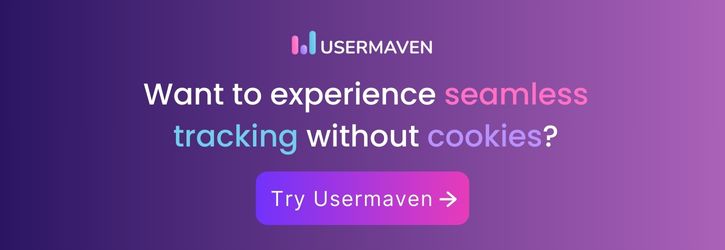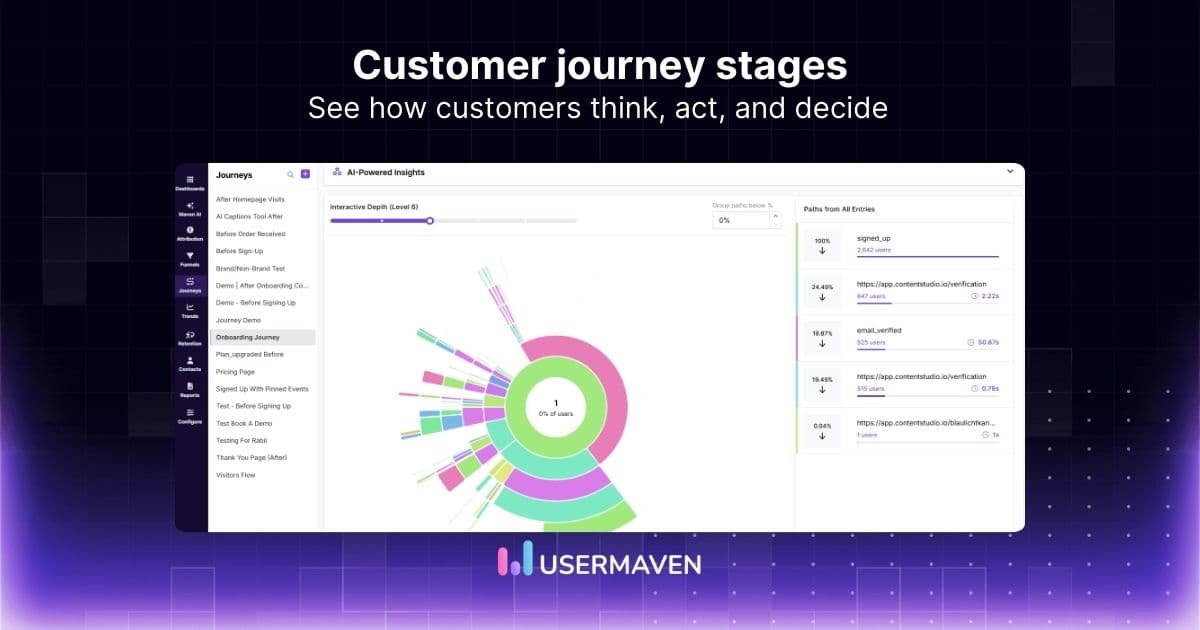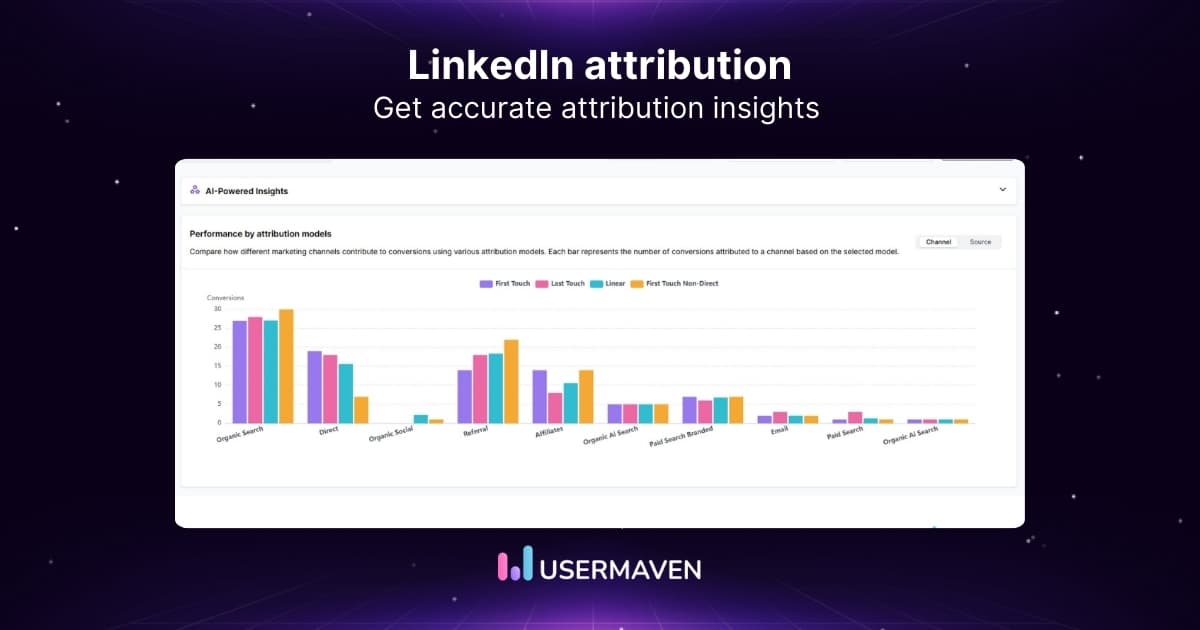What is cookieless tracking & how will it impact businesses
Jul 26, 2024
5 mins read
Written by Mahnoor Shahid
Have you ever thought about how 50% of people do not feel private online?
With more attention being paid to keeping user information safe and new rules getting tougher, the way cookies are used in digital marketing is really being looked at closely.
For a long time, marketers have relied on cookies to keep an eye on what users do online, make their experience better, and make sure their marketing efforts hit the mark.
But now, with stricter privacy laws coming into play and web browsers putting limits on cookies, companies need to rethink how they gather data without stepping over any lines.
In this blog post, we’ll dive into what it means for businesses that can’t rely on traditional cookie tracking anymore.
We’ll cover how tracking with and without cookies in Usermaven works and why it’s important for businesses to adopt this approach.
Understanding cookieless tracking
Cookieless tracking lets us see what people do online without needing to use the usual cookies. With more rules about privacy and browsers being strict on cookies, this way of checking what users do is getting a lot of attention in digital marketing.
Instead of using cookies, websites now collect data right from their servers through website analytics scripts. This kind of information is called “first-party data” because it’s gathered and kept by the website itself. Websites can figure out who’s visiting by looking at unique IP addresses or applying browser fingerprinting methods, helping them understand user actions without having to store personal details.
Browser fingerprinting works by giving each visitor a special ID based on things like how big their screen is, which browser they’re using, and what fonts they have installed. This makes it possible to keep track of someone across different times they browse without needing cookies. Plus, with machine learning technology, businesses can dig into this user behavior data for deeper insights.
Nowadays, laws like GDPR in Europe and CCPA in California are making it harder for companies to gather and use people’s info freely. Cookieless tracking offers a way that respects everyone’s privacy while still letting businesses learn from how users interact with their sites.
Why cookies are helpful?
Cookies might not be the go-to for tracking how people act online or gathering their info anymore, but they’ve been super important in digital marketing and come with a bunch of benefits.
Improving marketing efforts:
- Track user behavior and engagement.
- Measure the effectiveness of marketing strategies.
- Use data-driven insights to refine and enhance marketing approaches.
Personalizing user experiences:
- Analyze past user actions to determine preferences.
- Deliver content and recommendations tailored to individual tastes.
- Increase user satisfaction and engagement.
Gaining insights into user habits:
- Understand customer preferences and interests.
- Target ads and promotions to the most interested users.
- Enhance marketing ROI through precise targeting.
Despite their declining popularity for tracking user behavior, cookies have played a significant role in digital marketing by providing these benefits.
Why cookies are bad?
Cookies might seem helpful for things like making websites work better, knowing what you like, and helping companies show ads that match your interests. But there are some big downsides to them when we think about keeping our online lives private.
Privacy concerns:
- Cookies can track user activities across different sites without explicit consent.
- This tracking creates a feeling of constant surveillance, raising privacy concerns.
Ad annoyance:
- Targeted ads based on cookie tracking can become intrusive.
- This has led to increased use of ad blockers to avoid persistent, personalized ads.
Regulatory challenges:
- Businesses must comply with privacy regulations like GDPR and CCPA.
- Ensuring clear communication and consent from users for data collection is complex.
Reliability issues:
- Users can delete or block cookies, disrupting tracking efforts.
- This hinders businesses’ ability to accurately understand user behavior and impacts marketing campaign success.
Key methods of cookieless tracking
With cookies out of the picture, companies have different ways to keep an eye on what users do and gather information without them.
For starters, there’s something called server-side tracking. This happens when all the data is picked up and handled right by the website’s own server.
Then we’ve got first-party data collection. With this method, companies get a thumbs-up from users before pulling info through quizzes, forms for signing up, or just by watching how people interact with their site. 
Let’s see how these methods work;
Server-side tracking explained:
When we talk about server-side tracking, it’s all about a way to keep an eye on what happens on your website without using cookies. This means that everything is done through the website’s own server. It lets businesses have full control over how they collect and look at data.
With this approach, companies can see what users do on their site, check out the stats of the website, and learn important stuff without having to store any personal details on someone’s device.
This method gets rid of the old need for cookies and offers a more privacy-friendly option for watching what users do online. By going with server-side tracking, companies can make sure they’re following privacy laws while keeping user information safe but still getting useful info for things like marketing analysis and making their websites better. Understanding what is server-side tagging and implementing it can help businesses establish a corporate data strategy that prioritizes both data security and compliance with privacy regulations.
First-party data collection techniques:
Gathering first-party data means getting permission from users and collecting information when they interact with a website. There are quite a few ways companies can do this.
A popular method is by collecting email addresses. When businesses offer things like newsletter sign-ups or access to special content, they can get your email address. They use it to keep an eye on what you do on their site and make your experience more personal.
Other methods involve surveys, registration forms, or feedback forms that people fill out willingly. With these tools, companies get a better picture of who their audience is and collect important info for understanding the market better and making improvements.
By using these techniques to collect first-party data, companies can learn more about user behavior while making sure they respect everyone’s privacy according to privacy laws.
How Usermaven implement cookieless tracking?
Usermaven offers a comprehensive cookieless tracking solution designed to provide actionable insights without compromising user privacy. Here’s how Usermaven implements this technology:

Fingerprinting technology:
- User-agent: Analyzes the visitor’s browser and operating system, such as “Chrome on Windows 10.”
- IP address: This identifies the visitor’s device’s general location (city or country) via its IP address.
- These elements are combined through a sophisticated hashing algorithm, generating a unique identifier for each visitor without storing any personal information like names or browsing history.
Accuracy and functionality:
- Location: Identifies the city and country of visitors, providing valuable demographic data.
- Engagement: Tracks page views and session data to understand how users navigate your website.
- Interactions: Captures click events and user actions on buttons, forms, and other elements to paint a detailed picture of user behavior.
Privacy compliance:
- No PII storage: No personally identifiable information like names, emails, or browsing history is collected or stored.
- IP address anonymization: For EU/UK visitors, the last octet of IP addresses is masked to protect specific location data while still providing insights like city and country.
Additional benefits:
- Adblocker bypass: Unlike cookie-based tracking, cookie-less tracking bypasses adblockers, providing a more comprehensive picture of your website traffic.
- Reduced reliance on browser settings: Even if users have disabled cookies in their browser settings, Usermaven’s cookie-less tracking can still collect essential data.
Enabling and choosing between tracking modes
- Cookie-based tracking: Offers slightly higher accuracy in certain scenarios and supports advanced features like user segmentation, and finger but requires cookie consent management.
- Cookie-less tracking: Prioritizes user privacy and respects regulations like GDPR and CCPA. Bypasses adblockers and collects data even with disabled cookies, though accuracy might be slightly lower in specific situations.
GDPR compliance
Usermaven adheres to strict regulations like GDPR, CCPA, and PECR:
- Cookie consent: If privacy mode is off, collecting cookie consent for residents of the EU and UK is recommended. Implementing a switch on cookie_policy and ip_policy for users who haven’t consented to cookies or IP address tracking enhances user control and ensures compliance.
- Strict (cookie-less) mode: No need for traditional cookie banners since no cookies are stored. However, displaying an informational banner about the tracking method and giving users the option to manage their preferences is recommended.
Usermaven’s cookie-less tracking solution offers a privacy-first approach to analytics, respecting user privacy while providing valuable insights.
Related: Cookieless tracking in Usermaven
Conclusion
Cookies used to be okay, but now they’re not cutting it because people are more worried about their privacy than ever before. By getting good at using cookieless tracking methods for gathering information, companies can collect the data they need without stepping on anyone’s toes when it comes to privacy.
Getting ready for a future without cookies is smart—it helps build trust with folks out there and makes your strategies for handling data even better.
Usermaven ensures compliance with privacy regulations and maintains user trust. Whether you prioritize strict privacy compliance or require advanced cookieless tracking features, Usermaven provides flexible options to meet your needs.
FAQs
1. What is the difference between cookie-based and cookieless tracking?
Cookie-based tracking uses HTTP cookies stored on users’ devices to monitor online activity and interactions. Cookieless tracking gathers information directly from the website’s servers, bypassing cookies. Cookies raise privacy concerns, while cookieless tracking offers a more privacy-friendly approach.
2. How do I prepare my business for cookieless tracking?
Adopt a cookieless tracking solution that collects data from your website’s servers. Review your digital marketing strategies to ensure they comply with privacy regulations. Focus on collecting first-party data with user consent to implement a privacy-friendly business strategy.
3. Can cookieless tracking provide the same insights as traditional cookie-based tracking?
Yes, cookieless tracking can provide comparable insights to traditional cookie-based tracking. Although it employs different methods, it can still capture essential data on user behavior, engagement, and conversions, allowing businesses to make informed decisions without compromising user privacy.
Try for free
Grow your business faster with:
- AI-powered analytics & attribution
- No-code event tracking
- Privacy-friendly setup



